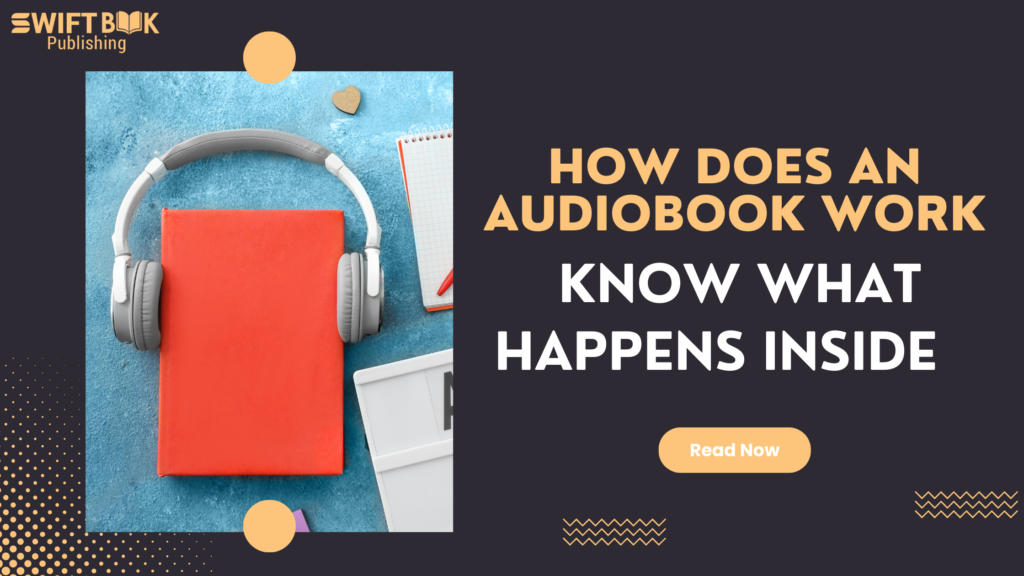Reading was considered one of the best times, but then the world got busy, and now no one has the time to even turn a single page. What we could spend hours on leisurely reading today is jam-packed with mundane activities like commuting, cooking, or doing laundry. With less and less time to open up a novel or a self-help book, we need to adapt to the situations. Audiobooks come as the solution to engaging with your favourite books on the go. As they open up stores in a new dimension, one must ask, how does an audiobook work?
If you’re looking for an answer, you’ve come to the right place. Here, we delve into audiobooks and what happens inside. We’ll cover the entire audiobook creation process, as well as the tools and software needed to make it happen. Additionally, we’ll look at the distribution phase. So, if you’re curious about how these digital audiobooks are made, here is your complete answer.
What Is an Audiobook?
Before we start breaking down concepts of audiobook production, lets first discuss what they are first so that everyone on the same page. Simply put an audiobook is a narrated version of a book designed for listening rather than reading.
Unlike traditional books, which require your full visual attention, including your eyes and limbs, audiobooks let you experience stories without them. This makes it easier to enjoy reading—or should we say listening—to your favorite book while multitasking, whether you’re commuting, cooking, or winding down for the night. But what is an audiobook exactly? It’s a narrated version of a book, bringing stories to life through voice, tone, and sound effects. That’s why audiobooks have skyrocketed in popularity, with millions of readers swapping paperbacks for a more immersive listening experience.
But how exactly do they work? Think of an audiobook as a professionally recorded performance—a narrator (or sometimes a full cast) reads the book aloud, often bringing characters to life with unique voices, accents, and emotions. Some audiobooks even add background music or sound effects to heighten the atmosphere. The final product is a polished, high-quality recording that lets listeners absorb the book’s content without ever needing to look at a page. Thanks to audiobook services, authors and publishers can now produce and distribute audiobooks more easily than ever.
Why Are Audiobooks So Popular?
There’s a reason people can’t get enough of audiobooks. They fit seamlessly into modern life, offering convenience, accessibility, and a richer storytelling experience than traditional reading.
For starters, audiobooks make reading effortless. If you’ve ever wished you had more time to get through your reading list, audiobooks are a game-changer. You can listen while driving, exercising, or doing chores, turning otherwise mundane moments into opportunities to enjoy great stories.
They’re also incredibly accessible. For people with visual impairments, reading difficulties, or conditions like dyslexia, audiobooks open up a world of literature that might otherwise be difficult to access. Many audiobook platforms offer speed control, bookmarks, and playback options, making it easier for listeners to engage with books at their own pace.
And then there’s the storytelling aspect. A great narrator can completely transform a book. Ever heard an author read their own work? It hits differently. Some narrators, like Stephen Fry or Jim Dale, have become legendary for the way they bring books to life. This added layer of emotion and performance makes audiobooks feel more like an experience rather than just a way to absorb information.
How to Create an Audiobook from Scratch?
Now that we’ve delved into what an audiobook is, let’s explore how to create an audiobook. Crafting an audiobook isn’t as simple as pressing record and reading out the entirety of the book. There is a lot that occurs when creating an audiobook. Understanding how to create an audiobook involves three key stages: Pre-Production, Recording, and Post-Production. Each phase plays a crucial role in bringing a book to life through sound.
Step 1: Pre-Production
Before the microphones are set up and the recording begins, thorough planning is essential. Recording is an expensive process, and unwanted hitches will cost. So, proper planning is crucial. Some things that follow in pre-production include:
a) Selecting the Right Book
While you can convert any book into an audiobook, not each one is suited for audio adaptation. It’s important to choose a book with engaging content that translates well into spoken word. Narrative flow, dialogue, and descriptive passages all influence how well a story can be conveyed through audio.
b) Hiring a Narrator or Voice Actor
The narrator is the voice of the audiobook, making the selection process critical. Professional narrators bring skill and experience, adding depth and emotion to the reading. However, like most quality things in life, there is a higher cost associated with hiring a professional voice actor. If budget is a constraint, you could alternatively check out productions that explore AI narration. While cost-effective, you do risk the nuanced touch of a human voice.
c) Preparing the Script
Transforming a written manuscript into an audio script involves careful formatting. This includes noting pauses, emphasizing certain words, and providing guidance on pronunciation. A well-prepared script ensures a smooth recording session and a coherent final product. Winging it without the script will only lead to problems down the road, the major one being that your audiobook is not selling.
Step 2: Recording
With preparations complete, the focus shifts to capturing the narration.
a) The Role of Professional Studios and Sound Engineers
Recording in a professional studio environment ensures high-quality sound. Sound engineers manage the technical aspects, from microphone placement to sound levels, ensuring clarity and consistency throughout the recording.
b) Bringing the Story to Life
A skilled narrator does more than just read the text; they animate it. Through variations in tone, pacing, and character voices, narrators infuse the story with energy and emotion, creating an immersive experience for listeners.
Step 3: Post-Production
After recording, the raw audio undergoes refinement to meet professional standards.
a) Editing the Audio
This stage involves removing errors, awkward pauses, and background noises. Editors also ensure that the pacing is consistent and that the audio aligns seamlessly with the script.
b) Adding Sound Effects or Music
In some cases, subtle sound effects or background music are incorporated to enhance the listening experience. However, it’s crucial to use these elements sparingly to avoid distracting from the narration.
Audiobook Production Mistakes to Steer Clear Of
Even with careful planning, certain pitfalls can hinder the success of an audiobook. Here are some common mistakes to avoid:
1. Using Substandard Recording Equipment
High-quality audio is paramount. Investing in good recording equipment prevents issues like distortion and background noise, which can detract from the listener’s experience.
2. Settling for Amateur Voice Talent
While it might be tempting to cut costs, using inexperienced narrators can result in a lacklustre performance. Professional voice actors bring the necessary expertise to deliver a compelling narration.
3. Improperly Preparing the Recording Environment
Recording in a noisy or acoustically poor environment can introduce unwanted sounds into the audiobook. Setting up a soundproofed and interruption-free space is essential for clean audio.
4. Insufficient Editing
Neglecting thorough editing can lead to mispronunciations, repeated lines, or awkward pauses, all of which disrupt the listener’s immersion. Diligent editing ensures a polished final product.
5. Overlooking Distribution Details
Failing to consider the distribution platform’s requirements can lead to delays or rejection. Ensure that the audiobook meets the technical specifications of platforms like Audible or iTunes.
The Technology Behind Audiobooks
Building upon our exploration of the audiobook creation process, let’s delve into the technology that makes it all possible.
Essential Must-Haves for Audiobook Production
1. High-Quality Microphones
Capturing clear and crisp audio starts with selecting the right microphone. Condenser microphones are often favoured for their sensitivity and ability to capture a broad frequency range, ensuring the narrator’s voice is recorded with precision.
2. Digital Audio Workstations (DAWs)
DAWs are software platforms used for recording, editing, and producing audio files. Popular choices include Pro Tools, Audacity, and Adobe Audition. These platforms offer a suite of tools for sound editing, mixing, and mastering, allowing producers to fine-tune every aspect of the audiobook.
3. Audio Interfaces
Serving as the bridge between microphones and computers, audio interfaces convert analog signals into digital data. This conversion is crucial for maintaining audio fidelity during the recording process.
5. Soundproofing Materials
To prevent unwanted background noise, recording environments are often treated with soundproofing materials. Acoustic panels, foam, and isolation shields help in creating a controlled acoustic environment, ensuring the purity of the recorded voice.
The Role of AI in Modern Audiobook Creation
Artificial Intelligence has made significant inroads into audiobook production, particularly through text-to-speech (TTS) technology. Advanced AI voice generators can produce natural-sounding narrations, offering a cost-effective and time-efficient alternative to traditional methods. Platforms like ElevenLabs utilize deep learning models to synthesize speech with human-like intonation and emotion, enhancing the listener’s experience.
Moreover, AI voice cloning enables the creation of digital replicas of a narrator’s voice, allowing for efficient production without compromising on quality. This technology is particularly beneficial for authors looking to produce multilingual audiobooks, as AI can generate narrations in multiple languages and dialects without the need for multiple voice actors.
Why Does High-Quality Audio Matter?
The success of an audiobook hinges on the quality of its audio. Listeners expect clear, engaging, and professionally produced sound. Poor audio quality can distract from the content and diminish the overall experience. Investing in high-quality recording equipment, utilizing advanced editing software, and employing soundproofing techniques are essential steps in ensuring that the final product meets industry standards and listener expectations.
How to Get Your Audiobook to Readers?
Recording and editing the audiobook is just the first half of the audiobook production. The other half involves distributing your creation to your intended audience. For effective distribution, you need to ensure you use proper distribution channels in the most common audio formats. Let’s look at them one by one.
1. Major Distribution Platforms
Audiobooks are primarily distributed through several key platforms:
- Audible: As a subsidiary of Swift, Audible stands as a leading platform, offering an extensive library of audiobooks across various genres.
- Apple Books: Integrated into Apple’s ecosystem, Apple Books provides users with a seamless audiobook experience on their devices.
- Spotify: Originally known for music streaming, Spotify has expanded its offerings to include a growing selection of audiobooks, making it a convenient choice for existing users.
These platforms not only host a vast array of titles but also offer user-friendly interfaces, personalized recommendations, and flexible purchasing or subscription models, enhancing the overall listener experience.
2. Common Audiobook Formats
Audiobooks are available in various digital formats, each with its own characteristics:
- MP3: A widely used format known for its compatibility and efficient compression, ensuring manageable file sizes without significant loss of audio quality.
- M4B: Similar to MP3 but with added features like bookmarking, allowing listeners to easily resume where they left off.
4. Accessibility for Diverse Audiences
Ensuring that audiobooks are accessible to all listeners, including those with visual impairments, is crucial. Platforms and producers implement several strategies to achieve this:
- Compatible Devices: Audiobooks are made available on devices that support accessibility features, such as screen readers and voice commands, facilitating ease of use for visually impaired users.
- Accessible Formats: Utilizing formats that support navigation aids, such as DAISY (Digital Accessible Information System), allows listeners to navigate through the audiobook efficiently.
- Inclusive Design: Ensuring that platforms and applications are designed with accessibility in mind, including customizable playback speeds, adjustable text sizes, and high-contrast interfaces, enhances usability for all listeners.
Final Note:
So, how does an audiobook work? As we’ve seen, it’s a complex process involving careful planning, skilled narration, professional recording and editing, and strategic distribution. From the initial spark of an idea to the moment a listener presses play, a lot goes into creating an audiobook. Understanding this process allows us to appreciate the artistry and technology that bring stories to life in a whole new way.
FAQs – Frequently Asked Questions
Q1: What exactly is an audiobook?
A: An audiobook is a narrated version of a book designed to be listened to rather than read. It’s a performance of the written word, often brought to life by professional narrators who use their voices to create distinct characters, convey emotions, and immerse the listener in the story. Audiobooks can range from simple, straightforward readings to elaborate productions with sound effects, music, and even multiple narrators.
Q2: Why are audiobooks so popular?
A: Audiobooks have gained immense popularity for several reasons. They offer unparalleled convenience, allowing people to “read” while multitasking – commuting, exercising, cooking, or doing chores. They’re also incredibly accessible, particularly for individuals with visual impairments or reading difficulties. Furthermore, a skilled narrator can elevate the storytelling experience, adding depth and nuance to the narrative in a way that reading alone sometimes can’t replicate.
Q3: How is an audiobook different from a book read aloud?
A: While both involve someone reading a book aloud, audiobooks are professionally produced. They aren’t simply recordings of someone reading at home. Audiobooks go through a rigorous process of recording in professional studios, editing to remove errors and unwanted noise, mastering to ensure consistent sound quality, and often include added elements like music or sound effects. The goal is to create a polished and immersive listening experience.
Q4: What’s involved in creating an audiobook?
A: Creating an audiobook is a multi-stage process. It begins with pre-production, which includes selecting the right book, hiring a narrator, and preparing the script. The recording phase takes place in a professional studio with sound engineers ensuring high-quality audio capture. Post-production involves editing the audio, adding any sound effects or music, and mastering the final product. Finally, the audiobook is distributed through various platforms.
Q5: What kind of equipment is used to create an audiobook?
A: Professional audiobook production relies on high-quality equipment. This includes sensitive condenser microphones to capture clear audio, digital audio workstations (DAWs) for recording and editing, audio interfaces to connect microphones to computers, and soundproofing materials to create a quiet recording environment.
Q6: What role does a narrator play in an audiobook?
A: The narrator is crucial to an audiobook’s success. They are more than just readers; they are performers. A skilled narrator brings the story to life, using their voice to create distinct characters, convey emotions, and set the tone. They can make a good book great and a great book unforgettable.
Q7: How are audiobooks distributed?
A: Audiobooks are typically distributed through online platforms like Audible, Apple Books, and Spotify. These platforms offer a vast selection of titles, user-friendly interfaces, and various purchase or subscription options. Distributors also ensure the audiobooks are available in common formats like MP3 and M4B.







